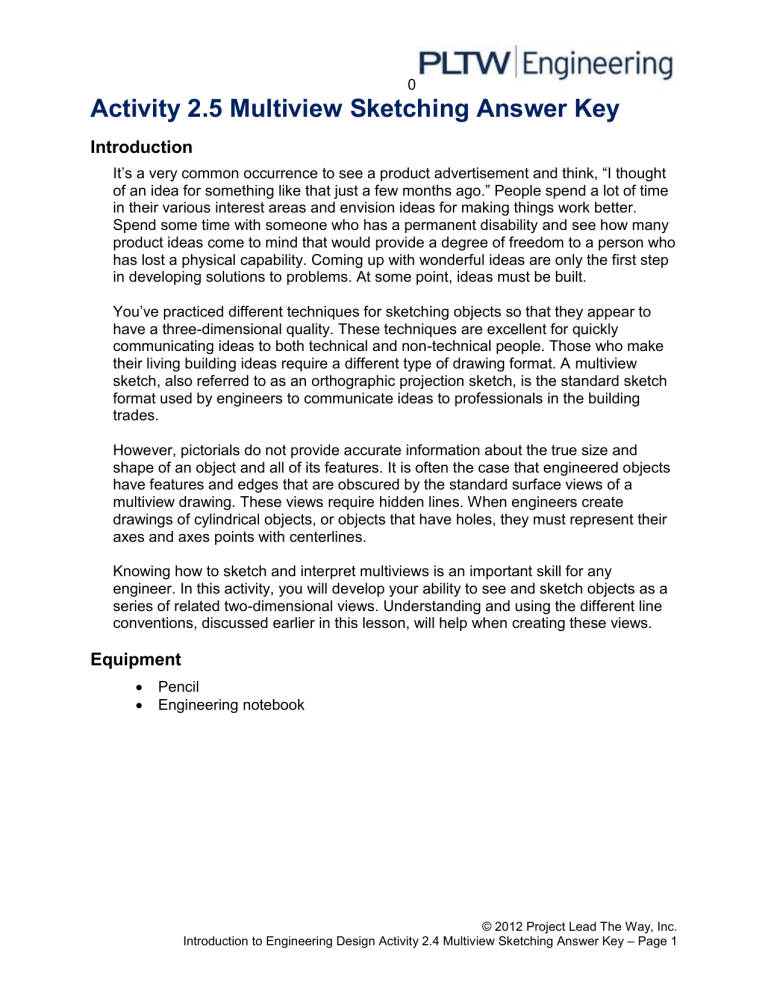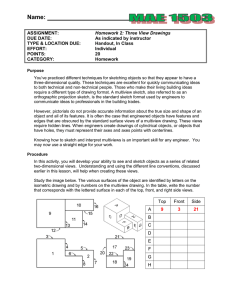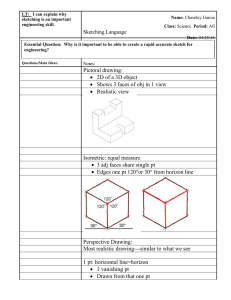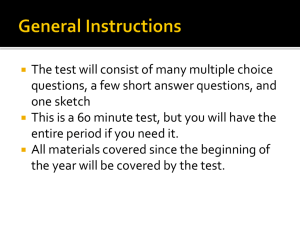
0 Activity 2.5 Multiview Sketching Answer Key Introduction It’s a very common occurrence to see a product advertisement and think, “I thought of an idea for something like that just a few months ago.” People spend a lot of time in their various interest areas and envision ideas for making things work better. Spend some time with someone who has a permanent disability and see how many product ideas come to mind that would provide a degree of freedom to a person who has lost a physical capability. Coming up with wonderful ideas are only the first step in developing solutions to problems. At some point, ideas must be built. You’ve practiced different techniques for sketching objects so that they appear to have a three-dimensional quality. These techniques are excellent for quickly communicating ideas to both technical and non-technical people. Those who make their living building ideas require a different type of drawing format. A multiview sketch, also referred to as an orthographic projection sketch, is the standard sketch format used by engineers to communicate ideas to professionals in the building trades. However, pictorials do not provide accurate information about the true size and shape of an object and all of its features. It is often the case that engineered objects have features and edges that are obscured by the standard surface views of a multiview drawing. These views require hidden lines. When engineers create drawings of cylindrical objects, or objects that have holes, they must represent their axes and axes points with centerlines. Knowing how to sketch and interpret multiviews is an important skill for any engineer. In this activity, you will develop your ability to see and sketch objects as a series of related two-dimensional views. Understanding and using the different line conventions, discussed earlier in this lesson, will help when creating these views. Equipment Pencil Engineering notebook © 2012 Project Lead The Way, Inc. Introduction to Engineering Design Activity 2.4 Multiview Sketching Answer Key – Page 1 Procedure 1. Study the images that follow. The various surfaces of the object are identified by letters on the isometric drawing and by numbers on the multiview drawing. In the table, write the number that corresponds with the lettered surface in each of the top, front, and right-side views. Top Front Right A 9 3 21 B 14 8 18 C 12 1 20 D 13 4 17 E 15 2 24 F 11 6 22 G 16 7 19 H 10 5 23 2. For each of the objects below, select the face that would provide the best front view. Then create a quick sketch of the front view. Finally, determine the minimum number of views required to adequately represent the object Add center lines and hiddens lines where appropriate on front view. Object Front View Sketch Minimum number of views: 1 if constant depth is written, 2 if constant depth is not written © 2012 Project Lead The Way, Inc. Introduction to Engineering Design Activity 2.4 Multiview Sketching Answer Key – Page 2 Object Front View Sketch Minimum number of views: 1 if constant depth is written and 2 if constant depth is not written Minimum number of views: 1 Center line lets you know it is cylindrical and you can dimension every diameter and width to the shape Minimum number of views: 2, If you make the front view the conecentric circles (red ink drawing), you cant see the depth of holes and the different depths of the plate. If you pick the front view with the center line on the yellow paper we need another view to dimension the diameter of the hoel, because we never dimension to hidden lines. We actually need both views drawn over there. If we were allowed to dimension to hidden lines or this was a solid object with no hole we would only need one view. © 2012 Project Lead The Way, Inc. Introduction to Engineering Design Activity 2.4 Multiview Sketching Answer Key – Page 3 Object Front View Sketch Minimum number of views: 2, wouldn’t know if the holes are in the middle of plate, depth wise(which they are) or more toward the front or back just from the one front view. You also can deimension the diameter of the holes to the hidden line. The top view is needed as well. Also you don’t kow if this object is boxy or curved. The centerlines tell you the hole is curved. Minimum number of views: 2, Wouldn’t know there are two depths. wouldn’t no if the holes are in the middle of plate (which they are) or more toward the front or back . We are not a loud to dimension the diamater of the hole to the hidden lines. Also couldn’t tell the right side of the front view is rounded. The top view is needed © 2012 Project Lead The Way, Inc. Introduction to Engineering Design Activity 2.4 Multiview Sketching Answer Key – Page 4 © 2012 Project Lead The Way, Inc. Introduction to Engineering Design Activity 2.4 Multiview Sketching Answer Key – Page 5 Study the isometric views in the next four pages. Use points, hidden lines, construction lines, and object lines to sketch the three common views used to explain the object. The scale is 1:1, which means that each grid line on the isometric view represents a grid line on the orthographic grid. DO NOT ERASE YOUR CONSTRUCTION LINES. 3. 1 view © 2012 Project Lead The Way, Inc. Introduction to Engineering Design Activity 2.4 Multiview Sketching Answer Key – Page 6 4. 2 views © 2012 Project Lead The Way, Inc. Introduction to Engineering Design Activity 2.4 Multiview Sketching Answer Key – Page 7 5. 2 views © 2012 Project Lead The Way, Inc. Introduction to Engineering Design Activity 2.4 Multiview Sketching Answer Key – Page 8 Extend Your Learning For each of the following, create an isometric sketch and properly aligned orthographic projections on grid paper. Use the minimum number of orthographic projections necessary to fully describe the object shown. Include object lines, hidden lines, and center lines in all views, as appropriate. The sketches should approximately proportional, but are not required to be drawn to scale. 6. Note: Only one view required if plate thickness is annotated. Otherwise, a top or right-side view can be used to show thickness. 7. 8. Note: Can use a top-side view instead of a right view. No center line not a cylinder Need depth of both layers Note: Can use a right-side view instead of a top view.need depth of both layers © 2012 Project Lead The Way, Inc. Introduction to Engineering Design Activity 2.4 Multiview Sketching Answer Key – Page 9 Conclusion Questions 1. What is the purpose of construction lines? Object lines? Construction lines are lightly drawn lines that guide the creation and drawing of other lines and shapes. Object lines indicate the edges of the object being represented. 2. What is the purpose of hidden lines and center lines? Hidden lines show edges of details that are not visible from the point of view shown in the drawing. Center lines define the center of arcs, circles, or symmetrical parts. 3. What are extension lines, leader lines and dimension lines? Dimension lines are lines used show distance of a side Leader lines are used to connect a feature of a drawing to some information about that feature. Extension Lines: Lines used to show where a dimension starts and stops on an object. 4. What type of pictorial is shown below? How can you tell? Two-point perspective. The depth lines recede to a single point and the height lines are as well. One-point- acceptable answer 5. What type of pictorial is shown below? How can you tell? © 2012 Project Lead The Way, Inc. Introduction to Engineering Design Activity 2.4 Multiview Sketching Answer Key – Page 10 Oblique. Both are oblique pictorials since the front view in each is drawn “straight on” with vertical height lines and horizontal width lines. Depth lines are parallel 6. What type of pictorial is shown below? How can you tell? isometric front view isn’t straight on looks like 30 degree and 120 degree anges and height are vertical lines 7. Why would building professionals, such as machinists and contractors, prefer multiview drawings over pictorial drawings? Multiview drawings provide true size and shape of each face of the object represented whereas a pictorial drawing (which may © 2012 Project Lead The Way, Inc. Introduction to Engineering Design Activity 2.4 Multiview Sketching Answer Key – Page 11 © 2012 Project Lead The Way, Inc. Introduction to Engineering Design Activity 2.4 Multiview Sketching Answer Key – Page 12




